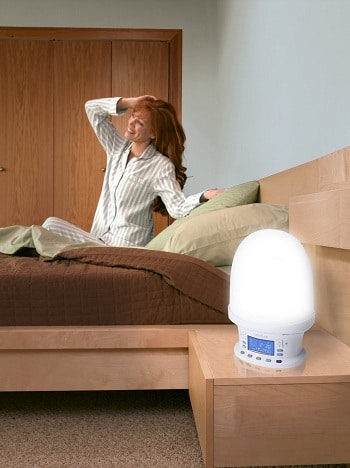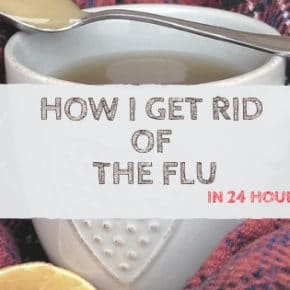The winter sneaks in, and suddenly you like someone put a dimmer on your happiness.
You feel lifeless and depressed. You are tired, want to sleep all the time, you avoid social contact, you feel lethargic and you constantly crave carbs.
The good news is:
You don’t have to live with it. You don’t have to wait for the spring to feel better, and you sure don’t need anti-depressants.
Beating the winter blues is simpler than you think.
In this post you’ll find:
- Why you feel lifeless, irritable and tired
- The 4 best natural, effective and fast ways to relieve seasonal depression
Ready to chase the dark away?
Page Contents
Why You Suffer from SAD
It wasn’t always so, but Seasonal Affective Disorder, a seasonal mild depression, is now a recognized (common) condition.
It usually starts in the fall as the nights get longer and the mornings get dark, and lasts all through the icy cold winter months.
Science has already found, through brain scans, the reasons for seasonal depression:
- As the nights draw longer and longer, the brain production of a transporter protein ramps up, lowering available serotonin.
As you know, Serotonin is an important contributor to feelings of well-being and happiness – if its levels are lowered, the overall mood tends to go down as well.
2. Vitamin D helps the body maintain levels of serotonin during the winter. Less sunlight means less Vitamin D and lost serotonin.
3. Melatonin (The “sleep hormone”) increases in darkness which is why you feel more tired.
So:
Since there’s no time machine (yet!) to launch us back to summer, this year we’re not going to let old man winter the satisfaction.
Beating The Winter Blues Naturally
Here are the 4 best natural, effective and fast ways to relieve seasonal affective disorder:
1. Bring in the Light
Light is possitively the best natural treatment for SAD.
[Tweet “When you are down with #SAD, The way you start your day will determine the rest of your day.”]Waking up in the dark is an awful way to start the day (More than that – It feels unnatural).
As explained above, Serotonin, the feel-good hormone, is sensitive to light. Melatonin, the “sleep hormone, decreases with exposure to light.
The solution?
Step #1 – Dawn Simulator (Waking up Energized)
The first thing to do is to wake up to gradually increasing light, as nature intended. This can be easily done by using a light therapy alarm clock, also known as a dawn simulator.
A dawn simulator works with your body’s natural rhythms to wake you up with gradually brightening light that re-sets your sleep/wake cycle to help you feel refreshed, alert and energized all day.
The Philips Wake up light is the #1 best-selling dawn simulator right now, and for good reasons.
I can’t imagine waking up to the heart-stopping and annoying traditional alarm clock ever again.
[yellowbox](If you want to know more – Here’s my post about the top 3 dawn simulators in 2016).[/yellowbox]
Step #2 – Bright Light Therapy (Every Morning)
The second step in busting your winter blues is using a bright light therapy box/lamp.
Bright Light therapy (10,000 LUX) is a first line treatment for winter depression and has an 80 percent success rate in relieving SAD symptoms – Without medication.
Bright light helps simulate that same response you’d get from being in the sunlight, but you need higher light intensities that get close to the brightness you’d see outside in summer.
A 2006 multicenter double-blind randomized controlled trial compared bright-light therapy with the popular antidepressant Prozac (fluoxetine).
[yellowbox]The study found the Prozac and bright light therapy equally effective for relieving winter blues.In fact, SAD light therapy produced faster results (usually within a week) – Without side effects./yellowbox]
All you have to do is use a 10,000 LUX light box for 30 minutes in the morning, while you read the paper or work on your computer, to make your entire day full of energy and cheerfulness, just like in the summer.
(Here’s more about how to choose the best light box for SAD)
2. Mood Lifting Foods (Who Wants Chocolate?)
Looking for a good medical reason to have some yummy dark chocolate?
You’ve just found it.
Dark chocolate has the ability to boost brain levels of endorphins (natural opiates) as well as serotonin. But try not to over do it:The recommended dose is 1 ounce a day.
Do you find yourself craving carbs?
This happens for a good reason. Carbohydrates help the brain release serotonin, but unfortunately can also contribute to weight gain, headaches and mood swings.
Luckily, if you don’t want to live on coolie dough for the rest of the winter, shun the simple carbs and say hello to complex carbs to boost your mood without the extra pounds.
– Complex carbs take longer to digest, which means they don’t cause spikes in blood sugar that can create mood swings. They also increase levels of serotonin in the brain while filling you up for many hours.
Examples for complex carbs are:
1. Legumes (Peas, lentils)
2. Brown rice
3. Starchy vegetables (Sweet potatoes, parsnips)
4. Spinach, Broccoli, beans, zucchini
Eat healthy fats, with omega-3 fatty acids – Omega-3 fatty acids are hypothesized to affect the functionality of serotonin in the brain.
You can find omega-3 fats in:
1. Fish, such as salmon, and fish oils (My ultimate daily supplement is Cod Liver Oil)
2. Nuts, seeds and seed oils, such as flax seed oil.
– Another good way to raise serotonin levels (and keep healthy all winter) is to take a Vitamin D supplement.
As explained, Vitamin D helps maintain serotonin levels throughout the winter. With no sunlight, Vitamin D levels drop, which is not only bad for your mental health, but to your physical health as well.
When you buy a supplement, make sure it’s Vitamin D3, the natural form of Vitamin D, and with the fewest additives (Like this one).
Foods & Drinks to Avoid
1. Avoid caffeinated drinks, like coffee and energy drinks. Caffeine suppresses serotonin and energy drinks contain a lot of sugar (short-term energy ending with a bad mood).
2. Avoid alcohol (I know, a tough one in the winter) – Alcohol is actually a depressant. It will make you feel worse.
Moderate drinking is fine for most people, but binge drinking – Not so much. Unless you want to feel sick, more tired and more depressed.
3. Exercise for Seasonal Blues (How to get Off the Sofa)
I know, I know. How can you consider going to the gym when there are so many grilles cheese sandwiches to be consumed?
When you suffer from winter blues, the last thing you have is motivation, and that includes working out motivation.
However, exercise is a proven depression buster and is one of the quickest ways to boost your mood for several hours after you hit the (nice long & hot) showers.
You’ll have more energy and your metabolism will be elevated too.
If you can’t even persuade yourself to take a nice long walk outside (which is best for you), consider getting a rebounder like the one I have.
Rebounding is the best exercise devised by man (ask NASA if you don’t believe me) and the best thing about it?
You can do it at home, in front of the TV, in your pajamas.
All I need to boost my mood is 2 minutes of jumping on a mini trampoline in my living room.
[yellowbox]Read more about rebounding benefits and how to start – HERE.[/yellowbox]
4. Social Activities (That’s What Friends Are For)
Though it’s tempting to hibernate and avoid seeing more people than necessary (aka family members) in winter – Do what ever you can to maintain your social activities.
Lolling around on your couch may feel good at the moment, but in the long run, being around your friends will brighten up your mood and make you feel alive again.
Conclusion
Beating seasonal affective disorder is easier than you ever thought.
Here’s something you didn’t know:
Just re-living happy memories can lift your serotonin levels and boost your mood. And vice versa – Re-living sad moments will decrease it.
Amazing, right?
If you can’t re-live happy times, look at old pictures or talk to your friends.
Use bright light therapy every moment to start your day right, eat complex carbs, try to get some exercise, listen to your favorite music, meditate.
That’s all you need to get through the winter blues this year and enjoy all the fun things in winter (yes, there are fun things in winter…) by the end of this week.
To your health & happiness,
Meital








Mitesh,
The secret to getting enough Vitamin D through the sun is not really about the hours, but about moderate exposure – Without getting burnt.
I would stay away from the sun in the “dangerous hours” (before and around noon), but the rest of the day is fine, as long as you don’t burn your skin, that’s all.
Hope this helps!
Thanks for those tips. In Utah I do tend to get a little depressed because it snows too and I don’t really want to go outside. BUT going outside when it’s not snowing makes me feel better or opening the windows! Even if it’s cloudy outside there usually a little natural light that can get in.
i like to have a fire going curl up with a soft blanket a good book hot tea or coffee & take advantage of the time I have indoors & appreciate it!
hi… very interesting article, esp for someone like me suffering from general anxiety disorder and is frequently feeling down…
one question : if vitamin D is available naturally in places with tropical climates like here in India, when is the IDEAL time to go for a walk in the sun? I’ve tried to get that info from various sites online, and no-one agrees on the ideal time for a sunbath! opinions differ from 7am to 6pm (with some hours being unhealthy to be exposed to the sun in!)…
If you know the answer or can find out, that would be a big help 🙂